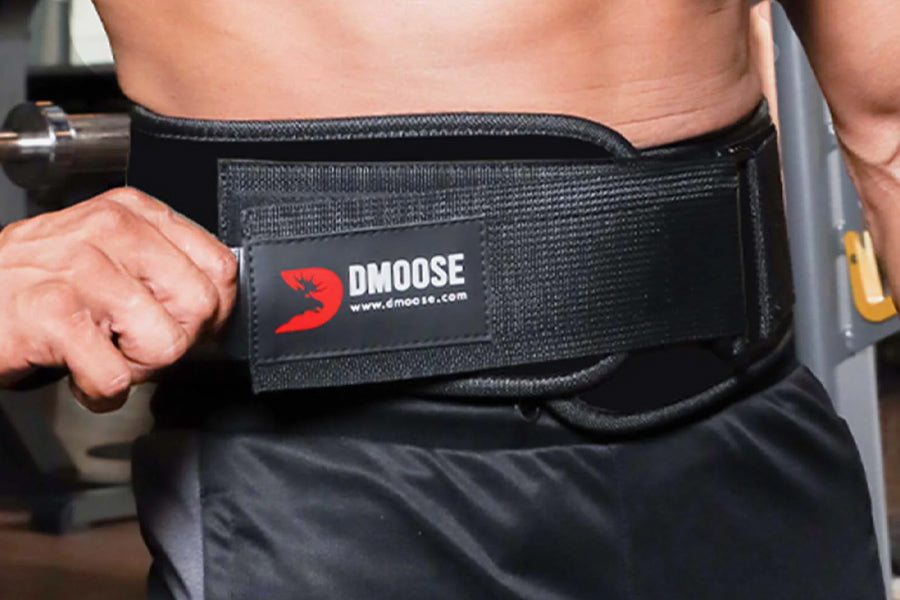Weightlifting belts have become a popular fitness equipment choice for beginners and experienced weightlifters. These belts offer multiple advantages that can help you maximize your results while lifting weights.
If you're still unsure what a weightlifting belt does or why you should wear one, there are five main benefits to consider that will boost your routine.
From promoting proper posture while lifting to providing extra strength, these five benefits are worth exploring and could make all the difference in whether or not you meet your fitness goals.
Related Article: 15 Best Weightlifting Belts for Powerlifters
5 Benefits You Should Know of Weight Lifting Belt
A weightlifting belt is designed to support your back during heavy lifting exercises. It wraps around your waist and helps stabilize the spine during compound movements.
The belt holds in the natural curvature of the lumbar spine (lower back) while engaging the core muscles through intra-abdominal pressure. This increases stability and allows you to lift heavier weights with more control and less risk of injury.
Weightlifting belts have become an increasingly popular accessory among gym-goers looking to increase their gains. The right belt can improve safety and provide stability and support for those challenging, intense lifts. While some debate whether a weightlifting belt is a necessary addition to your gym bag, here are five key benefits that may make you think twice about going without one.
Related Article: Exercises to Ease Your Back Pain and Restore Health
1. Increases Intra-Abdominal Pressure

When you lift heavy weights, you need to create a stable core to transfer the force from your lower body to your upper body. Wearing a weightlifting belt helps increase intra-abdominal pressure, stabilizing your core and supporting your spine. The pressure created by the belt acts as a brace to help you maintain proper form and technique during heavy lifts.
This increases intra-abdominal pressure, which engages the core muscles more than they would while exercising without a belt. By engaging your core more intensely, you are strengthening it and improving your overall core strength.
Not only does increased core stability help you lift heavier weights, but it also helps protect your spine during heavy lifts. By engaging your core muscles and stabilizing the spine, you are less likely to experience injury due to excessive strain on the lower back muscles or discs.
2. Provides Support & Reduces the Risk of Injury

Weightlifting can put a lot of stress on the lower back, and the risk of injury increases as the weight gets heavier. The weightlifting belt supports the lower back by limiting the range of motion of the spine, reducing the stress on the muscles and ligaments.
This can help reduce the risk of herniated discs, muscle strains, and sprains. The belt helps stabilize the spine by providing extra support for your lower back and abdominal muscles, which can help protect your spine during heavy lifts using dumbbells or barbells.
3. Improves Performance

Wearing a weightlifting belt can also help improve your performance by allowing you to lift heavier weights. The belt provides a solid base for your core muscles to push against, allowing you to generate more force and lift heavier weights. This increased performance can help you to reach your fitness goals faster and improve your overall strength and endurance.
By providing extra stability and support around your core, you can lift heavier weights with less risk of injury. This can help you increase strength and muscle size more quickly as you push yourself to your limits without worrying about hurting yourself.
The belt also helps improve lifting form by providing feedback when you slouch or move out of alignment. This allows you to correct your form before any potential injuries occur, which can lead to better results from each set.
Wearing a weightlifting belt also encourages proper breathing mechanics, allowing for better oxygen delivery. This can lead to more efficient workouts, as you won't waste energy on inefficient breathing patterns.
The most crucial purpose of a weightlifting belt is to provide support when executing heavier lifts such as squats or deadlifts. This support comes from the tightness of the belt, which helps keep your core muscles engaged and places less strain on your spine by helping to distribute the load across your entire body evenly. A weightlifting belt can help you push past your limits and lift heavier weights by providing this support.
4. Increases Confidence

Lifting heavy weights like dumbbells or barbells can be intimidating, especially if you're new to weightlifting or trying to lift heavier weights than before. Wearing a weightlifting belt can help increase your confidence by providing support and stability during your lifts. This can help you feel more secure and focused, allowing you to lift more confidently and intensely.
Another advantage of wearing a weightlifting belt is improved form while lifting. By allowing the user to keep their core tight and spine in neutral alignment, a weightlifting belt helps limit excessive lower back flexion or extension, which can lead to improper form and potential injury. The belt's additional stability makes it easier to execute lifts properly with good technique.
5. Enhances Recovery
Wearing a weightlifting belt can also help enhance recovery by reducing the stress on your lower back muscles and ligaments. The belt can help reduce soreness and fatigue by supporting your lower back, allowing you to recover faster and train more frequently. This can help you progress faster and achieve your fitness goals more quickly.
Overall, a weightlifting belt can benefit weightlifters of all levels. By increasing intra-abdominal pressure, providing support and reducing the risk of injury, improving performance, increasing confidence, and enhancing recovery, a weightlifting belt can help you to reach your fitness goals and become a stronger, more confident lifter.
FAQs
1. How to wear a weightlifting belt?
A weightlifting belt should be worn over your clothes and around the waist or hip area, depending on the lift you perform. It should be tight enough to provide support without being too uncomfortable. You can adjust it during sets by loosening or tightening the belt with the buckle.
2. When to start using a lifting belt?
It's recommended that beginners wait until they understand proper form and technique before using a weightlifting belt. Once you become more comfortable with your lifts, you can wear a belt for heavier sets or overhead press exercises to help maintain proper form and reduce the risk of injury.
3. What lifts should I use a belt for?
You should wear a weightlifting belt for heavy lifts such as squats, deadlifts, and overhead press exercises. This will help provide extra support for your core and back muscles, allowing you to lift heavier weights with better form and less risk of injury.
4. Do weight-lifting belts help lower back pain?
A weightlifting belt can help reduce lower back pain by providing extra support and spinal stabilization during heavy lifts. The belt helps distribute the load evenly across your body, reducing strain on your lower back muscles or discs. This can help prevent potential injuries and reduce discomfort.
5. How tight should my weightlifting belt be?
The belt should be snug around your waist but not too tight so that it is uncomfortable. You should be able to breathe normally while wearing the belt.
6. What is the best material for a weightlifting belt?
Leather and suede are two popular materials used in making weightlifting belts. Leather offers more support and durability, while suede provides comfort and breathability. Both materials can provide adequate support during lifting exercises.
The Bottom Line
A weightlifting belt is invaluable to help lifters achieve their goals. From improved performance and reduced injury risk to better form and increased motivation, the advantages provided by a weightlifting belt are hard to ignore! It's recommended that beginners wait until they understand proper form and technique before using a weightlifting belt.
However, once you have become more comfortable with your lifts, wearing a belt for heavier sets or overhead press exercises can help provide extra support for your core and back muscles, allowing you to lift heavier weights with better form and less risk of injury.
Additionally, wearing a weightlifting belt can help reduce lower back pain by providing extra support and stability for your spine when executing heavier lifts such as squats and deadlifts. Investing in a weightlifting belt can not only help improve your performance and reduce the risk of injury, but it can also help you stay focused on your form and technique during workouts to achieve better results.
So what are you waiting for? Get a weightlifting belt today and experience all the amazing benefits it offers!














